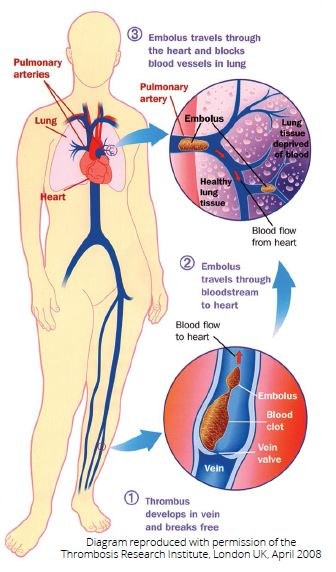Blood clots—DVT and PE information for A&E/UCC/outpatients
This information has been produced by the hospital Thrombosis and Thromboprophylaxis Group to help explain how a blood clot can develop and become a deep vein thrombosis (DVT) or a pulmonary embolism (PE). It will also discuss the signs and symptoms of blood clots. We hope it answers some of the questions you may have.

Deep Vein Thrombosis (DVT)
Deep vein thrombosis (DVT) is a common medical condition which occurs when a thrombus (blood clot) forms in a deep vein, usually in the leg or the pelvis. DVT can block off or reduce the flow of blood in the vein.
DVT in the leg or the pelvis can cause pain and swelling in the leg and may result in lifelong disability with painful leg swelling, varicose veins and leg ulcers.
Pulmonary Embolism (PE)
Sometimes the DVT (blood clot) in the leg breaks off and travels to the arteries of the lung where it will cause a pulmonary embolism (PE). PE may cause breathing difficulties and chest pain, and may be fatal.
Venous Thromboembolism (VTE)
DVT and PE are known under the collective term of venous thromboembolism (VTE).
How common are blood clots?
• VTE is one of the most common preventable causes of hospital deaths
Are you at risk of blood clots?
There are several factors that may increase the chances of developing VTE. If you have more than one of these factors, you may be considered to be at increased risk:
- If you are older than 60 years of age—the risk of VTE is higher the older you are (but young people can also get blood clots)
- If you have previously had DVT or PE, or a close member of your family (parents or brothers and sisters) has had DVT or PE
- Surgery increases the risk of developing blood clots
- If you have certain conditions such as active cancer, heart failure, lung disease or infections (eg. pneumonia)
- If you are immobile (eg unwell and confined to your bed) or if you have a leg injury and have a plaster cast or limited movement
- If you are obese
- If you are pregnant
- If you are taking a certain contraceptive pill or hormone replacement therapy tablets
What can you do to reduce the risk of developing blood clots?
- Keep mobile—move around as much as possible and do some foot exercises.
- Take care on journeys—for any long journeys, try to move your legs regularly and take breaks.
- Medications—talk to your doctor if you are taking the contraceptive pill or hormone replacement therapy tablets and if you think you have a number of risk factors for VTE.
- Preventative measures—will be considered if you are identified at increased risk of VTE and if appropriate. For example, you may be offered:
- Medication known as ‘blood thinners’—heparin injection is commonly used and is of animal (pig) origin—to thin your blood and prevent blood clots.
- Compression stockings may be offered in hospital to help the blood flow in your veins
- Please discuss with your doctor, nurse or pharmacist if you have any concerns
How can you help reduce your risk of blood clots?
Here is a simple exercise you can do, even when you are lying in bed, to help your blood to move around your body:
 |
|
Will your risk of blood clots be assessed?
If you are admitted to hospital, a doctor will assess your risk of DVT and PE. If you have a leg injury and require lower limb immobilisation (eg plaster cast), your risk of VTE and bleeding will be assessed in A&E, UCC and/or Fracture Clinic.
How will you know if you have DVT or PE?
The symptoms of DVT in the leg include:
- Swelling
- Pain
- Warm skin
- Tenderness
- Redness (particularly at the back of your leg below the knee)
DVT usually (although not always) affects one leg. In some cases, there may be no signs or symptoms of DVT at all in the leg.
The symptoms of PE include:
- Shortness of breath
- Coughing up blood or mucus that contains blood
- Chest pain that is sharp and is worse when taking a deep breath
- Collapse (in severe cases)
Both DVT and PE are serious conditions that require urgent investigation and treatment.
If you suspect you may have DVT or PE, you should seek medical advice immediately either from your GP or nearest A&E (Emergency Department).
Who can you contact for more information?
If you would like any more information or have any questions, please ask a doctor, nurse or pharmacist. Further information can be found from NHS.uk or Thrombosis UK.

